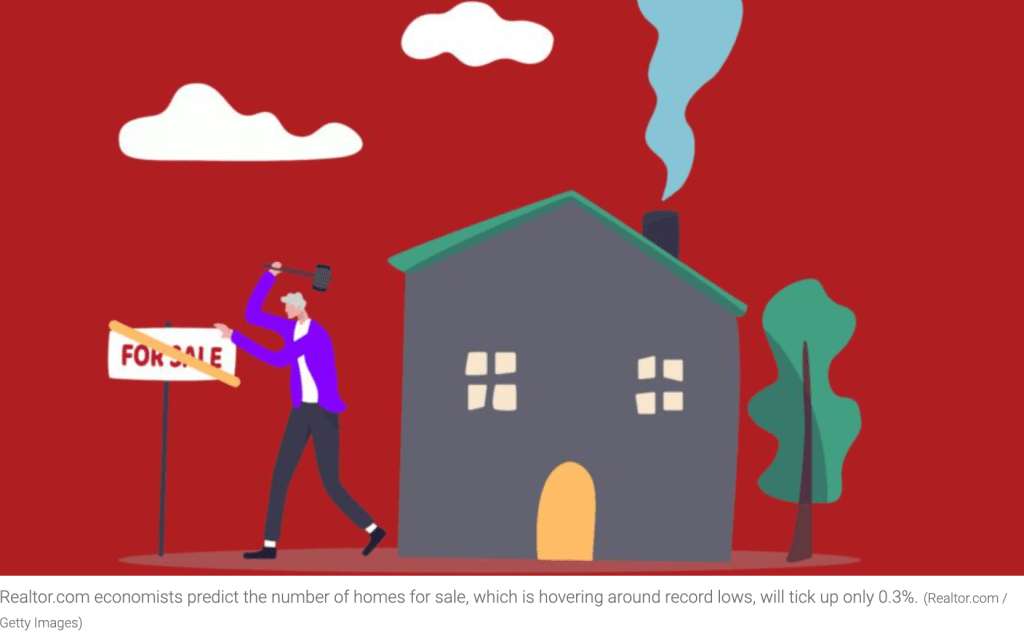
By Clare Trapasso
Dec 1, 2021
2 of a 3 part series
Highlights:
- “The shortage of homes for sale, that has been more than a decade in the making, will keep home prices high,”
- Millennials are a massive generation—next year, there will be more than 45 million millennials between the ages of 26 and 35, which are prime homebuying years.
Unfortunately, for frustrated buyers who have had trouble finding the right homes in the right locations at the right price, there isn’t expected to be a rush of homes hitting the market.
Realtor.com economists predict the number of homes for sale, which is hovering around record lows, will tick up only 0.3%. That’s partly due to builders having a tough time ramping up construction as they contend with shortages in workers and materials, compounded by the global supply chain backups. (Single-family housing starts, which is when builders start construction, is expected to rise only 5% next year.)
There are plenty of investors snapping up single-family homes and turning them into rentals. And there is no tidal wave of foreclosures expected to hit now that the government moratoriums are expiring.
There are also more homebuyers today than there are abodes for sale.
Millennials are a massive generation—next year, there will be more than 45 million millennials between the ages of 26 and 35, which are prime homebuying years. So there would need to be substantially more homes built to keep up with the needed housing—except builders stopped building during the Great Recession and there are fewer homes going up today.
“The shortage of homes for sale, that has been more than a decade in the making, will keep home prices high,” says Hale.
Sales will also continue to climb, hitting a 16-year high as they go up by 6.6%, Realtor.com economists anticipate. That’s partly because technology has sped up the homebuying process. Plus, buyers are jumping on whatever comes up for sale in record time before the property is snapped up by another eager buyer.
Attractively priced homes in good shape are expected to continue going under contract quickly.
“Homes are selling so much faster than they have in any previous [years],” says Hale.
That speed supports increased housing turnover as more abodes change hands as folks move into their first homes or relocate, trade up into larger residences, and downsize.
The popularity of the suburbs is also likely to endure. They emerged as the places to be during the pandemic as buyers could score more square footage and bigger yards for less money than in the bigger cities.
“For years, we heard about the dying suburbs because millennials didn’t want to live there, but as they age, guess where they’re heading?” asks Hale.
Some were even moving to the burbs before the pandemic.
“This budding trend was accelerated by the needs of aging millennials, often with families, trying to grapple head-on with the realities of doing more than ever before from home,” says Hale.
Remote work will also likely be a factor. With more workers telecommuting or going into the office only a few times a week, they don’t have to contend with grueling commutes five days a week. Many are more comfortable moving farther outside of the cities where they can get larger abodes with room for a home office at an attractive price.
That’s likely to keep prices high in desirable communities.
“Shoppers were looking for affordable homes with space that could be used flexibly to accommodate working, schooling, exercising, cooking, and all of the other living and relaxing we used to take for granted,” says Hale.
It won’t be easy for first-time homebuyers
First-time buyers are likely to continue struggling to compete with the offers over the asking price and win the bidding wars.
The ace in their pocket is the work-from-home phenomenon that has allowed many white-collar professionals to work from anywhere they have a strong Wi-Fi connection. So they may be able to relocate to cheaper destinations that make up for what they lack in Michelin star restaurants with more affordable home prices.
“Maybe they’re not buying a home in or near a major city where prices are high and the market is still competitive,” says Hale. “But they can move farther away from the city to the suburbs or to an entirely new city where it’s more affordable.”
The savings many who held on to their jobs were able to amass early on in the pandemic—when the stimulus checks went out and many folks cut back on dining out and traveling—may help them with the down payments. Some buyers temporarily moved back home with families or doubled up with friends to save on housing costs as well.
“I know a lot of people are expecting housing prices and sales to peak and then decline. Instead, I think there’s enough momentum from these younger buyers who want to get into the housing market to keep sales moving forward,” says Hale. “They are going to succeed because that drive to buy a home and make it happen when you’re ready is really strong.”
